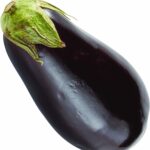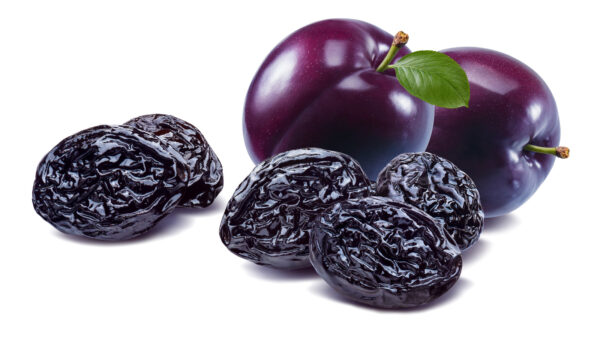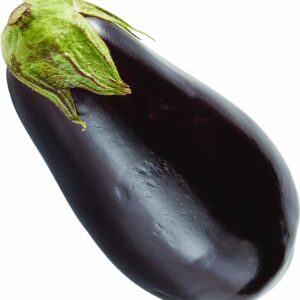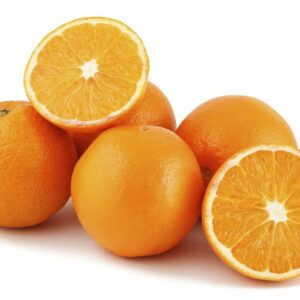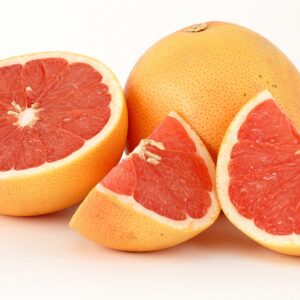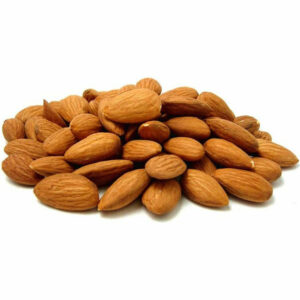Description
There are few fruits that come in such a panorama of colors as the juicy sweet tasting plum. The plum season extends from May through October with the Japanese varieties first on the market from May and peaking in August followed by the European varieties in the fall.
Plums belong to the Prunus genus of plants and are relatives of the peach, nectarine and almond. They are all considered “drupes,” fruits that have a hard stone pit surrounding their seeds.
Prunes are the dried version of European plums. In the United States, through, you may not see the term “prunes” used as frequently as before, as this fruit items recently had its name officially changed to “dried plum.” Sweet with a deep taste and a sticky chewy texture, prunes are not only fun to eat but they are also highly nutritious. As with other dried fruits, they are available year round.
1.00 2-1/8 inches
(66.00 grams)
GI: low
This chart graphically details the %DV that a serving of Plums & Prunes provides for each of the nutrients of which it is a good, very good, or excellent source according to our Food Rating System. Additional information about the amount of these nutrients provided by Plums & Prunes can be found in the Food Rating System Chart. A link that takes you to the In-Depth Nutritional Profile for Plums & Prunes, featuring information over 80 nutrients, can be found under the Food Rating System Chart.
- Health Benefits
- Description
- History
- How to Select and Store
- Tips for Preparing and Cooking
- How to Enjoy
- Nutritional Profile
- References
Health Benefits
Significant Antioxidant Protection from the Phenols in Plums and Prunes
The fresh version (plums) and the dried version (prunes) of the plant scientifically known as Prunus domestica have been the subject of repeated health research for their high content of unique phytonutrients called neochlorogenic and chlorogenic acid. These substances found in plum and prune are classified as phenols, and their function as antioxidants has been well-documented. These damage-preventing substances are particularly effective in neutralizing a particularly dangerous oxygen radical called superoxide anion radical, and they have also been shown to help prevent oxygen-based damage to fats. Since our cell membranes, brain cells and molecules such as cholesterol are largely composed of fats, preventing free radical damage to fats is no small benefit.
Better Iron Absorption Plus More Antioxidant Protection from Vitamin C
The ability of plums and prunes to increase absorption of iron into the body has also been documented in published research. This ability of plums and prunes to make iron more available may be related to the vitamin Ccontent of this fruit. Our food ranking system qualified plums as a very good source of vitamin C.
In addition to assisting with absorption of iron, vitamin C is needed in the body to make healthy tissue and is also needed for a strong immune system. Getting a little extra vitamin C around cold and flu season is a good idea, and may also be helpful for people who suffer from recurrent ear infections. Vitamin C also helps to protect cholesterol from becoming oxidized by free radicals. Since oxidized cholesterol is the kind that builds up in the arteries and causes damage to blood vessels, some extra vitamin C can be helpful for people who suffer from atherosclerosis or diabetic heart disease. In addition, vitamin C can help neutralize free radicals that could otherwise contribute to the development or progression of conditions like asthma, colon cancer, osteoarthritis, and rheumatoid arthritis, so vitamin C may be able to help those who are at risk or suffering from these conditions. Owing to the multitude of vitamin C’s health benefits, it is not surprising that research has shown that consumption of vegetables and fruits high in this nutrient is associated with a reduced risk of death from all causes including heart disease, stroke and cancer.
Prunes’ Potential for Normalizing Blood Sugar Levels and Helping with Weight Loss in Plums and Prunes
Prunes’ soluble fiber helps normalize blood sugar levels by slowing the rate at which food leaves the stomach and by delaying the absorption of glucose (the form in which sugar is transported in the blood) following a meal. Soluble fiber also increases insulin sensitivity and can therefore play a helpful role in the prevention and treatment of type 2 diabetes. And, prunes’ soluble fiber promotes a sense of satisfied fullness after a meal by slowing the rate at which food leaves the stomach, so prunes can also help prevent overeating and weight gain.
Prunes’ Fiber for Regularity, Lower Cholesterol, & Intestinal Protection
Prunes are well known for their ability to prevent constipation. In addition to providing bulk and decreasing the transit time of fecal matter, thus decreasing the risk of colon cancer and hemorrhoids, prunes’ insoluble fiber also provides food for the “friendly” bacteria in the large intestine. When these helpful bacteria ferment prunes’ insoluble fiber, they produce a short-chain fatty acid called butyric acid, which serves as the primary fuel for the cells of the large intestine and helps maintain a healthy colon. These helpful bacteria also create two other short-chain fatty acids, propionic and acetic acid, which are used as fuel by the cells of the liver and muscles.
The propionic acid produced from prunes’ insoluble fiber may also be partly responsible for the cholesterol-lowering properties of fiber. In animal studies, propionic acid has been shown to inhibit HMG-CoA reductase, an enzyme involved in the production of cholesterol by the liver. By lowering the activity of this enzyme, propionic acid helps lower blood cholesterol levels.
In addition, prunes’ soluble fibers help to lower cholesterol by binding to bile acids and removing them from the body via the feces. Bile acids are compounds used to digest fat that are manufactured by the liver from cholesterol. When they are excreted along with prunes’ fiber, the liver must manufacture new bile acids and uses up more cholesterol, thus lowering the amount of cholesterol in circulation. Soluble fiber may also reduce the amount of cholesterol manufactured by the liver.
Lastly, the insoluble fiber provided by prunes feed friendly bacteria in the digestive tract, which helps to maintain larger populations of friendly bacteria. In addition to producing the helpful short-chain fatty acids described above, friendly bacteria play an important protective role by crowding out pathogenic (disease-causing) bacteria and preventing them from surviving in the intestinal tract.
Description
One of the unique things about plums is that there are so many varieties available. Not only do over 2,000 varieties of plums exist, but over 100 are available in the United States alone. So, if you are looking for a juicy, sweet tasting fruit that comes in a panorama of colors, plums are for you.
Plums are classified into six general categories—Japanese, American, Damson, Ornamental, Wild and European/Garden—whose size, shape and colors vary. Although usually round, plums can also be oval or heart-shaped. The skins of plums can be red, purple, blue-black, red, green, yellow or amber, while their flesh comes in hues such as yellow, green and pink and orange—a virtual rainbow.
Plums belong to the Prunus genus of plants and are relatives of the peach, nectarine and almond. They are all considered “drupes,” fruits that have a hard stone pit surrounding their seeds. When plums are dried, they become the fruit we know as prunes.
Prunes are nutritious fruits that are extremely fun to eat since they have a sweet, deep taste and a sticky, chewy texture. Prunes are actually dried plums, more specifically the dried version of European plums, including the Agen variety.
Unfortunately for the delicious and quite beneficial prune, its name has acquired a somewhat negative connotation, being associated with wrinkles, old age and sluggish gastrointestinal tracts. As our Health Benefits section shows, nothing could be further from the truth. To give prunes some PR that may help overcome this stigma and to promote prunes to their rightful place in the American diet, they have been informally christened with another name, a name that reflects their heritage . . . the “dried plum.”
History
With the large number of plums available, it is not surprising that the various types have different heritages and places of origin. The European plum is thought to have been discovered around two thousand years ago, originating in the area near the Caspian Sea. Even in ancient Roman times, there were already over 300 varieties of European plums. European plums made their way across the Atlantic Ocean with the pilgrims, who introduced them into the United States in the 17th century.
While Japanese plums actually originated in China, they derived their name from the country where much of their cultivation and development occurred. Japanese plums were introduced to the U.S. in the late 19th century. Today, the United States, Russia, China and Romania are among the main producers of commercially grown plums.
The process of drying plums to make prunes is thought to have originated thousands of years ago in an area near the Caspian Sea, the same region where the prune-producing European plums originated. They spread throughout Europe with the migration of different cultures and civilizations.
The process of drying plums to produce prunes took hold in California, now the leading producer of prunes worldwide, in the mid-19th century when Louis Pellier planted grafted plum tree cuttings brought back with him from his native France. Among these trees were those belonging to the Agen variety, the type of plum that is extremely well suited to be dried to make prunes.
How to Select and Store
Plums
If you want to purchase plums that are ripe and ready to eat, look for ones that yield to gentle pressure and that are slightly soft at their tip. While you can also purchase plums that are firm and ripen them at home, avoid those that are excessively hard as they will be immature and will probably not develop a good taste and texture profile. Good quality plums will feature a rich color and may still have a slight whitish bloom, reflecting that they have not been overhandled. They should also be free of punctures, bruises or any signs of decay. Plums are generally available in the marketplace from May through the early fall.
Plums that are not yet ripe can be left at room temperature. As this fruit tends to mature quickly, check on them in the next day or two to ensure that they do not become overripe. Once they are ripe, plums can be stored in the refrigerator for a few days. While plums can be frozen, to ensure maximum taste remove their stone pits before placing them in the freezer.
Prunes
Prunes are sold either with their pits or already pitted. The form you choose should depend upon your personal preference and recipe needs.
Ideally, you should purchase prunes that are sold in transparent containers so that you can evaluate them for quality. They should be plump, shiny, relatively soft and free of mold. If the packages are opaque, ensure that they are tightly sealed so that the prunes will not have lost any moisture. As with any other dried fruit, try to purchase prunes that are not processed with food preservatives such as sulfites.
Prunes should be stored in an airtight container in a cool, dry and dark place where they will keep for several months. Storing them in the refrigerator will extend their freshness, allowing them to keep for about six months. Regardless of where you store them, make sure that when you open the container, you reseal it tightly to prevent the prunes from losing moisture.
Plums and Prunes
At WHFoods, we encourage the purchase of certified organically grown foods, and plums and prunes are no exception. Repeated research studies on organic foods as a group show that your likelihood of exposure to contaminants such as pesticides and heavy metals can be greatly reduced through the purchased of certified organic foods, including plums and prunes. In many cases, you may be able to find a local organic grower who sells these fruits but has not applied for formal organic certification either through the U.S. Department of Agriculture (USDA) or through a state agency. (Examples of states offering state-certified organic foods include California, New York, Oregon, Vermont, and Washington.) However, if you are shopping in a large supermarket, your most reliable source of organically grown plums and prunes is very likely to be plums and prunes that display the USDA organic logo.
Tips for Preparing and Cooking
Tips for Preparing Plums
Plums are delicious eaten as is. If the plums have been in the refrigerator, allow them to approach room temperature before eating them as this will help them attain the maximum juiciness and sweetness. If you want to first remove the pit before eating or cooking, cut the plum in half lengthwise, gently twist the halves in opposite directions and then carefully take out the pit.
Plums can also be used in a variety of recipes and are usually baked or poached. If you want to remove the skin, this process can be made easier by first blanching the plum in boiling water for 30 seconds. Once you remove the fruits from the water, quickly run them under cold water before peeling to stop the blanching process and allow for easier handling.
Tips for Preparing Prunes
If you have prunes that are extremely dry, soaking them in hot water for a few minutes will help to refresh them. If you are planning on cooking the prunes, soaking them in water or juice beforehand will reduce the cooking time.
How to Enjoy
PLUMS
A Few Quick Serving Ideas
- Make pizza with a twist by broiling sliced plums, goat cheese, walnuts and sage on top of a whole wheat pita bread or pizza crust.
- For a delightful dessert, poach plums in a red wine and serve with lemon zest.
- Bake pitted plum halves in a 200°F(93°C) oven until they are wrinkled. Then mix them into a rye bread recipe for a scrumptiously sweet and hardy bread.
- Blend stewed plums and combine with yogurt and honey for wonderful cold soup.
- Add plum slices to cold cereal.
WHFoods Recipes That Feature Plums
- 5-Minute Fresh Plums in Sweet Sauce
If you’d like even more recipes and ways to prepare plums the Nutrient-Rich Way, you may want to explore The World’s Healthiest Foods book.
PRUNES
A Few Quick Serving Ideas
- Serve stewed prunes with rosemary-scented braised lamb and enjoy this Middle Eastern inspired meal.
- Serve stewed or soaked prunes on top of pancakes and waffles.
- Combine diced dried prunes with other dried fruits and nuts to make homemade trail mix.
- Prunes make a delicious addition to poultry stuffing.
If you’d like even more recipes and ways to prepare prunes the Nutrient-Rich Way, you may want to explore The World’s Healthiest Foods book.
WHFoods Recipes That Feature Prunes
- Hot Polenta Breakfast with Dried Fruit Compote
- Millet with Dried Fruit Compote
- Prunes in Orange Sauce
- 15-Minute Dark Chocolate Truffles
Nutritional Profile
Plums are a very good source of vitamin C. They are also a good source of vitamin K, copper, dietary fiber and potassium.
Introduction to Food Rating System Chart
In order to better help you identify foods that feature a high concentration of nutrients for the calories they contain, we created a Food Rating System. This system allows us to highlight the foods that are especially rich in particular nutrients. The following chart shows the nutrients for which this food is either an excellent, very good, or good source (below the chart you will find a table that explains these qualifications). If a nutrient is not listed in the chart, it does not necessarily mean that the food doesn’t contain it. It simply means that the nutrient is not provided in a sufficient amount or concentration to meet our rating criteria. (To view this food’s in-depth nutritional profile that includes values for dozens of nutrients – not just the ones rated as excellent, very good, or good – please use the link below the chart.) To read this chart accurately, you’ll need to glance up in the top left corner where you will find the name of the food and the serving size we used to calculate the food’s nutrient composition. This serving size will tell you how much of the food you need to eat to obtain the amount of nutrients found in the chart. Now, returning to the chart itself, you can look next to the nutrient name in order to find the nutrient amount it offers, the percent Daily Value (DV%) that this amount represents, the nutrient density that we calculated for this food and nutrient, and the rating we established in our rating system. For most of our nutrient ratings, we adopted the government standards for food labeling that are found in the U.S. Food and Drug Administration’s “Reference Values for Nutrition Labeling.” Read more background information and details of our rating system.
|
Plum, fresh
1.00 2-1/8 inches 66.00 grams Calories: 30
GI: low |
||||
| Nutrient | Amount | DRI/DV (%) |
Nutrient Density |
World’s Healthiest Foods Rating |
|---|---|---|---|---|
| vitamin C | 6.27 mg | 8 | 5.0 | very good |
| vitamin K | 4.22 mcg | 5 | 2.8 | good |
| copper | 0.04 mg | 4 | 2.6 | good |
| fiber | 0.92 g | 3 | 1.9 | good |
| World’s Healthiest Foods Rating |
Rule |
|---|---|
| excellent | DRI/DV>=75% OR Density>=7.6 AND DRI/DV>=10% |
| very good | DRI/DV>=50% OR Density>=3.4 AND DRI/DV>=5% |
| good | DRI/DV>=25% OR Density>=1.5 AND DRI/DV>=2.5% |
In-Depth Nutritional Profile
In addition to the nutrients highlighted in our ratings chart, here is an in-depth nutritional profile for Plums & Prunes. This profile includes information on a full array of nutrients, including carbohydrates, sugar, soluble and insoluble fiber, sodium, vitamins, minerals, fatty acids, amino acids and more.
| Plum, fresh (Note: “–” indicates data unavailable) |
||
| 1.00 2-1/8 inches (66.00 g) |
GI: low | |
| BASIC MACRONUTRIENTS AND CALORIES | ||
|---|---|---|
| nutrient | amount | DRI/DV (%) |
| Protein | 0.46 g | 1 |
| Carbohydrates | 7.54 g | 3 |
| Fat – total | 0.18 g | 0 |
| Dietary Fiber | 0.92 g | 3 |
| Calories | 30.36 | 2 |
| MACRONUTRIENT AND CALORIE DETAIL | ||
| nutrient | amount | DRI/DV (%) |
| Carbohydrate: | ||
| Starch | — g | |
| Total Sugars | 6.55 g | |
| Monosaccharides | 5.46 g | |
| Fructose | 2.03 g | |
| Glucose | 3.34 g | |
| Galactose | 0.09 g | |
| Disaccharides | 1.09 g | |
| Lactose | 0.00 g | |
| Maltose | 0.05 g | |
| Sucrose | 1.04 g | |
| Soluble Fiber | 0.30 g | |
| Insoluble Fiber | 0.62 g | |
| Other Carbohydrates | 0.07 g | |
| Fat: | ||
| Monounsaturated Fat | 0.09 g | |
| Polyunsaturated Fat | 0.03 g | |
| Saturated Fat | 0.01 g | |
| Trans Fat | 0.00 g | |
| Calories from Fat | 1.66 | |
| Calories from Saturated Fat | 0.10 | |
| Calories from Trans Fat | 0.00 | |
| Cholesterol | 0.00 mg | |
| Water | 57.57 g | |
| MICRONUTRIENTS | ||
| nutrient | amount | DRI/DV (%) |
| Vitamins | ||
| Water-Soluble Vitamins | ||
| B-Complex Vitamins | ||
| Vitamin B1 | 0.02 mg | 2 |
| Vitamin B2 | 0.02 mg | 2 |
| Vitamin B3 | 0.28 mg | 2 |
| Vitamin B3 (Niacin Equivalents) | 0.37 mg | |
| Vitamin B6 | 0.02 mg | 1 |
| Vitamin B12 | 0.00 mcg | 0 |
| Biotin | — mcg | — |
| Choline | 1.25 mg | 0 |
| Folate | 3.30 mcg | 1 |
| Folate (DFE) | 3.30 mcg | |
| Folate (food) | 3.30 mcg | |
| Pantothenic Acid | 0.09 mg | 2 |
| Vitamin C | 6.27 mg | 8 |
| Fat-Soluble Vitamins | ||
| Vitamin A (Retinoids and Carotenoids) | ||
| Vitamin A International Units (IU) | 227.70 IU | |
| Vitamin A mcg Retinol Activity Equivalents (RAE) | 11.38 mcg (RAE) | 1 |
| Vitamin A mcg Retinol Equivalents (RE) | 22.77 mcg (RE) | |
| Retinol mcg Retinol Equivalents (RE) | 0.00 mcg (RE) | |
| Carotenoid mcg Retinol Equivalents (RE) | 22.77 mcg (RE) | |
| Alpha-Carotene | 0.00 mcg | |
| Beta-Carotene | 125.40 mcg | |
| Beta-Carotene Equivalents | 136.95 mcg | |
| Cryptoxanthin | 23.10 mcg | |
| Lutein and Zeaxanthin | 48.18 mcg | |
| Lycopene | 0.00 mcg | |
| Vitamin D | ||
| Vitamin D International Units (IU) | 0.00 IU | 0 |
| Vitamin D mcg | 0.00 mcg | |
| Vitamin E | ||
| Vitamin E mg Alpha-Tocopherol Equivalents (ATE) | 0.17 mg (ATE) | 1 |
| Vitamin E International Units (IU) | 0.26 IU | |
| Vitamin E mg | 0.17 mg | |
| Vitamin K | 4.22 mcg | 5 |
| Minerals | ||
| nutrient | amount | DRI/DV (%) |
| Boron | 278.50 mcg | |
| Calcium | 3.96 mg | 0 |
| Chloride | — mg | |
| Chromium | — mcg | — |
| Copper | 0.04 mg | 4 |
| Fluoride | 0.00 mg | 0 |
| Iodine | — mcg | — |
| Iron | 0.11 mg | 1 |
| Magnesium | 4.62 mg | 1 |
| Manganese | 0.03 mg | 1 |
| Molybdenum | — mcg | — |
| Phosphorus | 10.56 mg | 2 |
| Potassium | 103.62 mg | 2 |
| Selenium | 0.00 mcg | 0 |
| Sodium | 0.00 mg | 0 |
| Zinc | 0.07 mg | 1 |
| INDIVIDUAL FATTY ACIDS | ||
| nutrient | amount | DRI/DV (%) |
| Omega-3 Fatty Acids | 0.00 g | 0 |
| Omega-6 Fatty Acids | 0.03 g | |
| Monounsaturated Fats | ||
| 14:1 Myristoleic | 0.00 g | |
| 15:1 Pentadecenoic | 0.00 g | |
| 16:1 Palmitol | 0.00 g | |
| 17:1 Heptadecenoic | 0.00 g | |
| 18:1 Oleic | 0.09 g | |
| 20:1 Eicosenoic | 0.00 g | |
| 22:1 Erucic | 0.00 g | |
| 24:1 Nervonic | 0.00 g | |
| Polyunsaturated Fatty Acids | ||
| 18:2 Linoleic | 0.03 g | |
| 18:2 Conjugated Linoleic (CLA) | — g | |
| 18:3 Linolenic | 0.00 g | |
| 18:4 Stearidonic | 0.00 g | |
| 20:3 Eicosatrienoic | 0.00 g | |
| 20:4 Arachidonic | 0.00 g | |
| 20:5 Eicosapentaenoic (EPA) | 0.00 g | |
| 22:5 Docosapentaenoic (DPA) | 0.00 g | |
| 22:6 Docosahexaenoic (DHA) | 0.00 g | |
| Saturated Fatty Acids | ||
| 4:0 Butyric | 0.00 g | |
| 6:0 Caproic | 0.00 g | |
| 8:0 Caprylic | 0.00 g | |
| 10:0 Capric | 0.00 g | |
| 12:0 Lauric | 0.00 g | |
| 14:0 Myristic | 0.00 g | |
| 15:0 Pentadecanoic | 0.00 g | |
| 16:0 Palmitic | 0.01 g | |
| 17:0 Margaric | 0.00 g | |
| 18:0 Stearic | 0.00 g | |
| 20:0 Arachidic | 0.00 g | |
| 22:0 Behenate | 0.00 g | |
| 24:0 Lignoceric | 0.00 g | |
| INDIVIDUAL AMINO ACIDS | ||
| nutrient | amount | DRI/DV (%) |
| Alanine | 0.02 g | |
| Arginine | 0.01 g | |
| Aspartic Acid | 0.23 g | |
| Cysteine | 0.00 g | |
| Glutamic Acid | 0.02 g | |
| Glycine | 0.01 g | |
| Histidine | 0.01 g | |
| Isoleucine | 0.01 g | |
| Leucine | 0.01 g | |
| Lysine | 0.01 g | |
| Methionine | 0.01 g | |
| Phenylalanine | 0.01 g | |
| Proline | 0.02 g | |
| Serine | 0.02 g | |
| Threonine | 0.01 g | |
| Tryptophan | 0.01 g | |
| Tyrosine | 0.01 g | |
| Valine | 0.01 g | |
| OTHER COMPONENTS | ||
| nutrient | amount | DRI/DV (%) |
| Ash | 0.24 g | |
| Organic Acids (Total) | — g | |
| Acetic Acid | — g | |
| Citric Acid | — g | |
| Lactic Acid | — g | |
| Malic Acid | — g | |
| Taurine | — g | |
| Sugar Alcohols (Total) | — g | |
| Glycerol | — g | |
| Inositol | — g | |
| Mannitol | — g | |
| Sorbitol | — g | |
| Xylitol | — g | |
| Artificial Sweeteners (Total) | — mg | |
| Aspartame | — mg | |
| Saccharin | — mg | |
| Alcohol | 0.00 g | |
| Caffeine | 0.00 mg | |
Note:The nutrient profiles provided in this website are derived from The Food Processor, Version 10.12.0, ESHA Research, Salem, Oregon, USA. Among the 50,000+ food items in the master database and 163 nutritional components per item, specific nutrient values were frequently missing from any particular food item. We chose the designation “–” to represent those nutrients for which no value was included in this version of the database. |
||
References
- Ballot D, Baynes RD, Bothwell TH, et al. The effects of fruit juices and fruits on the absorption of iron from a rice meal. Br J Nutr 1987 May;57(3):331-43. 1987. PMID:13550.
- Bhatia IS, Bajaj KL. Tannins in black-plum (Syzygium cumini L.) seeds. Biochem J 1972 Jun;128(1):56P. 1972. PMID:13560.
- Cho E, Seddon JM, Rosner B, Willett WC, Hankinson SE. Prospective study of intake of fruits, vegetables, vitamins, and carotenoids and risk of age-related maculopathy. Arch Ophthalmol. 2004 Jun;122(6):883-92. 2004. PMID:15197064.
- Egbekun MK, Akowe JI, Ede RJ. Physico-chemical and sensory properties of formulated syrup from black plum (Vitex doniana) fruit. Plant Foods Hum Nutr 1996 Jun;49(4):301-6. 1996. PMID:13540.
- Ensminger AH, Ensminger, ME, Kondale JE, Robson JRK. Foods & Nutriton Encyclopedia. Pegus Press, Clovis, California. 1983.
- Ensminger AH, Esminger M. K. J. e. al. Food for Health: A Nutrition Encyclopedia. Clovis, California: Pegus Press; 1986. 1986. PMID:15210.
- Fortin, Francois, Editorial Director. The Visual Foods Encyclopedia. Macmillan, New York. 1996.
- Khaw KT, Bingham S, Welch A, et al. Relation between plasma ascorbic acid and mortality in men and women in EPIC-Norfolk prospective study: a prospective population study. European Prospective Investigation into Cancer and Nutrition. Lancet. 2001 Mar 3;357(9257):657-63. 2001.
- Kurl S, Tuomainen TP, Laukkanen JA et al. Plasma vitamin C modifies the association between hypertension and risk of stroke. Stroke 2002 Jun;33(6):1568-73. 2002.
- Nakatani N, Kayano S, Kikuzaki H, et al. Identification, quantitative determination, and antioxidative activities of chlorogenic acid isomers in prune (Prunus domestica L. ). J Agric Food Chem 2000 Nov;48(11):5512-6. 2000. PMID:13580.
- Wood, Rebecca. The Whole Foods Encyclopedia. New York, NY: Prentice-Hall Press; 1988. 1988. PMID:15220.
